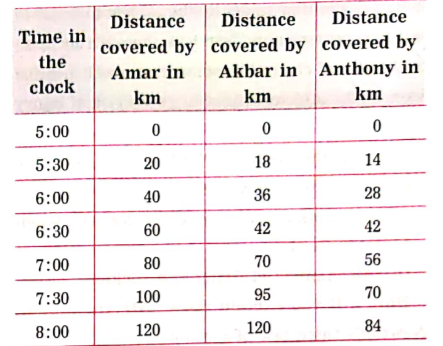Use your brain power:
Amar, Akbar and Anthony are travelling in different cars with different velocities. The distance covered by them during different time intervals are given in the following table.
Considering the distances covered by Amar, Akbar, Anthony in fixed time intervals, what can you say about their speeds?
 Solution in Marathi
Solution in Marathi
Step by step video & image solution for Use your brain power: Amar, Akbar and Anthony are travelling in different cars with different velocities. The distance covered by them during different time intervals are given in the following table. Considering the distances covered by Amar, Akbar, Anthony in fixed time intervals, what can you say about their speeds? by Physics experts to help you in doubts & scoring excellent marks in Class 9 exams.
Updated on:21/07/2023Topper's Solved these Questions
- LAWS OF MOTIONBOOK - NAVNEET PUBLICATIONCHAPTER - LAWS OF MOTIONEXERCISE - EXERCISE
196 Videos
- CURRENT ELECTRICITYBOOK - NAVNEET PUBLICATIONCHAPTER - CURRENT ELECTRICITYEXERCISE - EXERCISE
215 Videos
- MEASUREMENT OF MATTERBOOK - NAVNEET PUBLICATIONCHAPTER - MEASUREMENT OF MATTEREXERCISE - EXAMPLES
1 Videos
Similar Questions
Complete the sentences and explain them:
The minimum distance between the start and finish points of the motion of an object is called the ........ of the object.
View SolutionFill in the blanks:
The coulomb is the SI unit of………….
View SolutionWhat is the Dalton's atomic theory?
View SolutionAmar,Akbar and Anthony are three friends pursuing different carrers. (a) Amar is a doctor and is running his own clinic. (b) Akbar runs a bakery and makes breads and biscuits, whereas (c) Anthony is an IAS officer. Your are required to: (i) Identify their occupations and (ii) Differentiate between them on the basis of transfer of interest, reward and code of conduct.
View SolutionWhat is the distance covered in a given time interval?
View SolutionAmar, Akbar and Anthony are playing a game. Amar climbs 5 stairs and gets down 2 stairs in one turn. Akbar goes up by 7 stairs and comes down by 2 stairs every time. Anthony goes 10 stairs up and 3 stairs down each time. Doing this they have to reach to the nearest point of 100th stairs and they will stop once they find it impossible to go forward. (They have less number of stairs than required forward stairs).
Who reaches the nearest point?
View Solutionएक कार द्वारा चली गईं दूरी तथा इस दूरी को तय करने में लगा समय सारणी में दिए गए हैं। इससे दूरी-समय ग्राफ खींचिए।

View Solutionउपयुक्त पैमाने का प्रयोग करते हुए, निम्न तालिकाओं में दी गई राशियों के लिए आलेख बनाइए- कार द्वारा तय की गई दूरी कार के 100 km दूरी तय कर लेने पर समय क्या था?

View SolutionPaheli and Boojho have to cover different distances to reach their school but they take the same time to reach the school. What can you say about their speed?
View SolutionThe ratio of the speeds of Amar and Akbar is 8 : 5 . If Akbar takes 15 min more than Amar to cover a certain distance , then find the time taken by Akbar to cover the same distance
View SolutionAmar was as old as Anthony is now, when Akbar was as old as Anthony was 3 years ago. If the sum of their present ages is 37 years and the ratio of present ages if Akbar and Anthony is 6 : 5, How much percent more is the sum of ages of Amar and Akbar more than the sum of present ages of Amar and Anthony?
View SolutionThree men Amar, Akbar and Anthony speak of their hotel 3:4:5 Amar agrees to pay the first day's bill in the ratio of ₹ 26.65 Akbar gives the second day's bill ₹ 42.75 and Anthony 3rd day bill ₹ 53.00 What happens when they merge their accounts?
View SolutionAnswer the following questions: The following table shown the distance covered by a car in fixed time intervals. Draw a graph of distance against time taking 'time' along the X-axis and 'distance' along the Y-axis.
View SolutionUse your brain power: Amar, Akbar and Anthony are travelling in different cars with different velocities. The distance covered by them during different time intervals are given in the following table. What is the time interval between the noting's of distances made by Amar, Akbar and Anthony?
View SolutionUse your brain power: Amar, Akbar and Anthony are travelling in different cars with different velocities. The distance covered by them during different time intervals are given in the following table. Who has covered equal distance in equal time intervals?
View Solution
